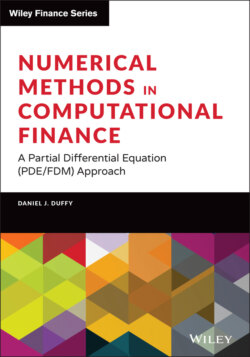Читать книгу Numerical Methods in Computational Finance - Daniel J. Duffy - Страница 36
2.2.1 Qualitative Properties of the Solution and Maximum Principle
ОглавлениеBefore we introduce difference schemes for (2.1), we discuss a number of results that allow us to describe how the solution behaves. First, we wish to conclude that if the initial value and inhomogeneous term are positive, then the solution should also be positive for any value in . This so-called positivity or monotonicity result should be reflected in our difference schemes (not all schemes possess this property). Second, we wish to know how the solution grows or decreases as a function of time. The following two results deal with these issues.
Lemma 2.1 (Positivity). Let the operator be defined in Equation (2.1), and let be a well-behaved function satisfying the inequalities:
Then the following result holds true:
Roughly speaking, this lemma states that you cannot get a negative solution from positive input.
You can verify it by examining Equation (2.2) because all terms are positive.
The following result gives bounds on the growth of .
Theorem 2.1 Let be the solution of Equation (2.1). Then:
This result states that the value of the solution is bounded by the input data. In other words, it is a well-posed problem.
We wish to replicate these properties in our difference schemes for Equation (2.1).
For completeness, we show the steps to be executed in order to produce the result in Equation (2.2).
(2.3)
Then from Equation (2.1) we see:
or:
Integrating this equation between and gives:
This style of mathematical analysis will be used in other contexts in this book, for example when transforming convection-diffusion-reaction equations (in particular, the Black–Scholes equation) to adjoint form.
